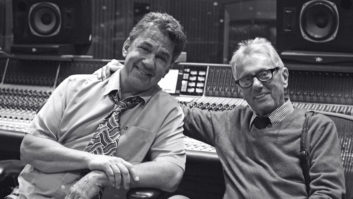I’ll admit it, I’m no Al Schmitt! But who is? Al’s heard and seen it all since before the tumultuous ’60s, and he’s still at the top of his game. I started engineering in 1981, and I’m still learning … like most of you out there. Over the years I’ve amassed what I call F2’s Top Ten Recording Tips, and it always fascinates me how many young engineers ignore my Rule #1: Start with the room!
“Well of course I do,” you may reply. Not so fast, Grasshopper!
Many of you, when you walk into a room for the first time, will ask the assistant (assuming there’s an assistant), “Where do folks usually place the drums?” Those more conscientious might actually scope out the room by looking or clapping, but seldom is that decision based on a methodical testing of the room’s characteristics. Often the choice on where to place the drum room mics involves more thought than where to place the actual drums.
Al can put the mics wherever he wants, but when it comes to the rest of us mortals, a few minutes of experimentation can do wonders. When I walk into a room for the first time, the first thing I do is walk the room with a kick drum, snare drum and cymbal in hand.
I move to the various areas in the room, methodically place the bass drum, snare and cymbal at each spot, and hit them, listening to the sounds of each. I then start taking notes:
1. Position 1
a. Bass drum – great low end, nice punch, a bit hollow and muted
b. Snare – good bottom, but no crack
c. Cymbal – thin and splashy
2. Position 2
a. Bass drum – no bottom, nice top
b. Snare – ok bottom, punchy
c. Cymbal – natural
3. Position 3 – Well, you get the picture.
If the room has been well designed, you will find at least one place where the bottom on the kick is deep, the top on the snare is ballsy, and the cymbal doesn’t overpower everything. You will be amazed at how much better the kit can sound simply by moving a foot or two.
Related: The METAlliance Report: How to Choose the Right Microphone, by Frank Filipetti and George Massenburg, Nov. 26, 2018
I’ve had the privilege to design four great-sounding (IMHO) rooms: Studios A, B, C at Right Track, and Studio A509 at Legacy, all in Midtown Manhattan. Yet as well as I knew those rooms (and I knew every nook and cranny), I would still go through this procedure whenever time allowed. Rooms are affected not only by their size and shape, but by the barometric pressure, the temperature and the humidity, to name just a few factors, and you will be amazed at how in one particular area in that room, the whole sonic texture suddenly coalesces into a bold and focused sound.
But I hear you ask, “Surely when close-miking a kit, the room contribution is minimal?” Again, not so fast, Grasshopper. I offer the following exhibits:
EXHIBIT A: As a drummer, I know that a great sound in the room inspires me. Inspiration leads to a more emotional performance.
EXHIBIT B: As an engineer, I know that a great sound to begin with has a better chance of sounding great through the microphone.
EXHIBIT C: Although you are close-miking individual drums, the room has more influence on the sound getting into those mics than you might imagine. Even dismissing the contribution of the overheads, that room contributes 10 to 30 percent of the sound. If you’re like me, where my drum sound consists of mostly kick and overheads that can go as high as 50 or 60 percent—and we’re not even talking about “room” mics here.
The sound of the drum at any spot in the room influences the sound of the drum into the microphone. I have recorded close mics for the bass drum, snare and cymbal at two different areas in the room and you’d be astonished at how different the sound in the control room can be. And that doesn’t even factor into the equation how much better the drummer feels.
When we went up to Martha’s Vineyard to record James Taylor’s Hourglass in a rented cottage, the first thing I did was go into each room of the cottage with Carlos Vegas’ kick, snare and cymbal to spot the optimum drum sound. It turned out the drums sounded best in the living room next to a stone fireplace. The rest of the band was referenced to this.
Related: The METAlliance Report: What’s Next?, by Elliot Scheiner, March 20, 2019
But what if we’re only recording a vocal?
The same rules apply. Oftentimes the vocal is placed in the smallest iso booth during a session. The problem with a small iso booth is that the first reflections often occur within the 30 ms Haas window, and impart a nasal, scooped or hollow quality to the voice, especially on power notes. For instance, we had that problem while recording Jonathan Davis of Korn; our solution was to surround him with foam by building a booth within the iso booth. This allowed Jonathan to project with full intensity without experiencing the inevitable comb filtering that would otherwise occur.
Likewise, when recording Munky and Head’s guitars on that album, we placed each guitar cabinet in a foam enclosure to keep the cabinets from interacting with each other. The idea there was to allow each cabinet its own unique sound without the room or the other cabs homogenizing that sound.
Related: The METAlliance Report: Al Schmitt on ‘Emotions in the Mix,’ by Al Schmitt, Dec. 21, 2018
In a previous METAlliance Report (December 2018), Al talked about mixing with emotion. A lot of what he said applies to recording as well. Working the room enhances the sound, which motivates the musicians, which inspires the artist, which jumpstarts the emotion—and that means a better recording.
So do yourself a favor: Get a room! Walk the room. Listen to how remarkably different that kit, or vocal or guitar sounds depending on where they are in the room. You will be very glad you did.
Paying Attention
Why do we engineers focus so much attention on the drums? Well, to begin with, they form the foundation (or the center) of most popular music forms, but more importantly, they are the instrument with the broadest frequency response and widest dynamic range. A bass drum can go as low as the lowest contrabass, while the snare and cymbals go higher than a piccolo. Their dynamic range is well over the capabilities of the finest recorder.
In addition, they normally involve the use of several microphones with conflicting phase response. So, to get a good drum sound, all your ducks have to be in a row—which is why they are so difficult to record.
Multiple Grammy-winner Frank Filipetti’s credits include Number One singles as Foreigner’s “I Want to Know What Love Is” and “I Don’t Want to Live Without You” (which he also produced), KISS’ “Lick It Up” and The Bangles’ “Eternal Flame.” He’s worked with acts ranging from Korn and Fuel to Barbra Streisand and Elton John, and has also produced, recorded or mixed albums for Carly Simon, George Michael, Dolly Parton, Rod Stewart, Luciano Pavarotti and James Taylor, among many others.
METAlliance • www.metalliance.com
The METAlliance—Al Schmitt, Chuck Ainlay, Ed Cherney, Elliot Scheiner, Frank Filipetti and George Massenburg, along with the late Phil Ramone—has the dual goals of mentoring through our “In Session” events, and conveying to audio professionals and semi-professionals our choices for the highest quality hardware and software by shining a light on products worthy of consideration through a certification process and product reviews in this column. Our mission is to promote the highest quality in the art and science of recording music.
Want more stories like this? Subscribe to our newsletter and get it delivered right to your inbox.







